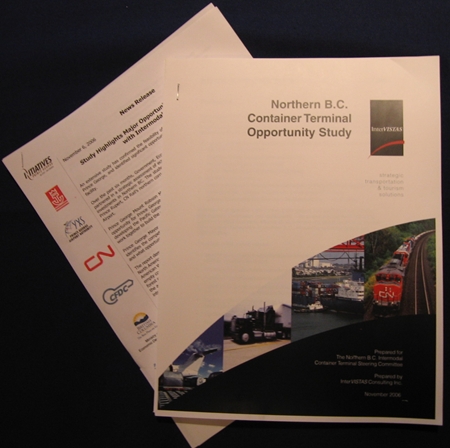Inland Container Report Study In
By 250 News

This is it, the 57 page report that outlines the opportunities presented by the creation of an inland container port in Prince George.
Its all about opportunities says Prince George Airport Authority boss Steig Hoeg, and this report paints the picture of what can happen for those who get on board for an inland container port in Prince George.
The report says utilizing the back-haul opportunites presented by the development of the new Prince Rupert Port, there is a potential to create 75 - 100 new jobs in the Prince George area, and as many as 340 jobs spread throughout the region.
According to the report, that would create more than $44 million in wages. The authors of the report says most of the jobs would be the traditionally higher paying positions.
To start, the study says the focus should be on shipping forest products . The report says forest products in Northern B.C. last year generated "enough lumber and pulp exports to East Asia to fill 62 thousand containers." The study expects P.G. could handle 30 thousand containers coming in, and shipping 30 thousand out each year.
The next steps involve spreading the word, as the container facility and warehousing has to be in place by the time the Rupert port opens in the fall of 2007. That leaves a realatively short window. "There are already plenty of things being done " says Don Zurowski of Community Futures Development Corporation. "Some industries have been putting things in place, but those are their announcements to make". Northern Development Trust Chair Bruce Sutherland says he knows there is already activity underway "I get phone calls every week for the past year, and there is a lot of stuff in the works, and as Don says, they will announce, but there are a lot of things happening already."
At right, NDI Trust Chair, Bruce Sutherland;, P.G. Mayor Colin Kinsley; Airport Authority Manager Steig Hoeg; Don Zurowski of Community Futures Development Corp; and Ministry of Economic Development rep, Tim Barry at session which detailed report
Katherine Scouten of Initiatives Prince George says there has already been interest expresed by some industries about the possibilities "Industry is the one that is driven more than we are to have that port open (inland container port). It is the opportunity the private sector is already well familiar with that will be driving the urgency for it to be open. In the interim , we will continue to move forward, in some of these areas we already have some activity, so its accelerating and focusing them."
CN has been noted to be making adjustments to its operations on First Avenue, and there has been a great deal of activity in the former BCR site.
The Premier has already indicated there is provincial support for an inland port facility, and the Northern Developments Initiatives Trust recently loaned the Airport $11 million to expand its runways and develop an air cargo facility. That is one third of the overall cost of that project.
In addition, land owners near the airport have recently had property removed from the Agricultural land reserve and rezoned for light industrial use.
The challenge now is to get the message out to all communities along the 16 - 97 corridor so they can benefit from the possibilities presented by an inland port.
The complete report is available by clicking here.
Previous Story - Next Story
Return to Home









1. The report mentioned on page 37 (page 48 of the electronic version) that Huntsville Alabama and Columbus Ohio had foreign trade zones (free-trade zones). I did not notice that in the report's summary. It think that will be an important factor in improving Prince George's ability to draw as much business as possible.
This link gives the advantages of such zones in the USA in point form:
http://www.elpasointernationalairport.com/ftz.html
2. The First Avenue CN yards are shown as a possible site. That may cause the downtown of PG never accessing the river. Then again, looking at the postive side, if the City takes the postion that they will support such a move if the development is carried out in such a way that the facility is bridged at several locations by a connection of downtown to the river. I believe that can be done if everyone from business to the three levels of government work on it from the start.
On the other hand, the BCR south area may be more appropriate since it is less constrained by urban development and has potentially easier highway access, including the fact that it is situated on the envisaged link improvement between 16 and 97.